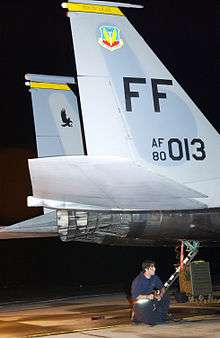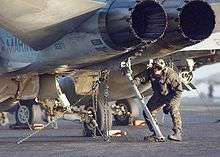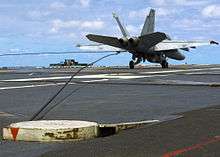Tailhook

A tailhook, arresting hook, or arrester hook is a device attached to the empennage (rear) of some military fixed-wing aircraft. The hook is used to achieve rapid deceleration during routine landings aboard aircraft carrier flight decks at sea, or during emergency landings or aborted takeoffs at properly equipped airports.
History

On January 18, 1911, Eugene Ely landed his Curtiss pusher airplane on a platform on the armored cruiser USS Pennsylvania anchored in San Francisco Bay. Ely flew from the Tanforan airfield in San Bruno, California and landed on the Pennsylvania, which was the first successful shipboard landing of an aircraft.[1][2] This flight was also the first ever using a tailhook system, designed and built by circus performer and aviator Hugh Robinson. Ely told a reporter: "It was easy enough. I think the trick could be successfully turned nine times out of ten."
Description

The tailhook is a strong metal bar, with its free end flattened out, thickened somewhat, and fashioned into a claw-like hook. The hook is mounted on a swivel on the keel of the aircraft, and is normally mechanically and hydraulically held in the stowed/up position. Upon actuation by the pilot, hydraulic or pneumatic pressure lowers the hook to the down position. The presence of a tailhook is not evidence of an aircraft's aircraft carrier suitability. Carrier aircraft hooks are designed to be quickly raised by the pilot after use. Many land-based fighters also have tailhooks for use in case of a brake/tire malfunctions, aborted takeoffs, or other emergencies. Land-based aircraft landing gear and tailhooks are typically not strong enough to absorb the impact of a carrier landing,[3] and some land-based tailhooks are held down with nitrogen pressure systems that must be recharged by ground personnel after actuation.[3]
Arresting gear

Both carrier- and land-based arresting gear consists of one or more cables (aka “arresting wires” or “cross deck pendants”) stretched across the landing area and attached on either end to arresting gear engines through “purchase cables”.
Use

Prior to making an "arrested landing", the pilot lowers the hook so that it will contact the ground as the aircraft wheels touch down. The hook then drags along the surface until an arresting cable, stretched across the landing area, is engaged. The cable lets out, transferring the energy of the aircraft to the arresting gear through the cable. A "trap" is often-used slang for an arrested landing. An aircraft which lands beyond the arresting cables is said to have "boltered." Occasionally, the tailhook bounces over one or more of the wires, resulting in a "hook skip bolter."[4]
In the case of an aborted land-based takeoff, the hook can be lowered at some point (typically about 1000 feet) prior to the cable.
Should a tailhook become inoperative or damaged, sea-based aircraft have limited options: they can divert to shore runways, or they can be "barricaded" on the carrier deck by a net that can be erected.
Testing
In the 1950s, as jet aircraft began to operate from carriers, landing speeds and tailhook loads increased. The US Navy developed a test rig. It consisted of a car, guided by a concrete I-beam and propelled by two jet engines. At the end of a one-mile run the tailhook under test would engage an arresting wire. The I-beam guide slowly widened to slow down the test car after it passed the arresting wire, in the event of failure. Different aircraft weights and speeds are tested by loading steel plates on the unit.[5] Further testing in 1958 used 4 Allison J33 jet engines.[6]
See also
References
- ↑ http://www.history.navy.mil/photos/events/ev-1910s/ev-1911/ely-pa.htm Accessed February 8, 2007.
- ↑ http://www.history.navy.mil/photos/pers-us/uspers-e/eb-ely.htm Accessed February 8, 2007.
- 1 2 http://www.aerospaceweb.org/question/planes/q0295.shtml
- ↑ http://www.wings-of-gold.com/cnatra/CNAF%203740.1%20(CQ)%20Sep03.pdf
- ↑ "Twin Jet Monorail Test Airplane Arresting Gear." Popular Science, June 1955, p. 97.
- ↑ Dempewolff, Richard F. (June 1958). Jet "Donkeys" for the Jets. Popular Mechanics. pp. 72–75. Retrieved 25 October 2012.
External links
| Wikimedia Commons has media related to Tail hooks (aircraft). |